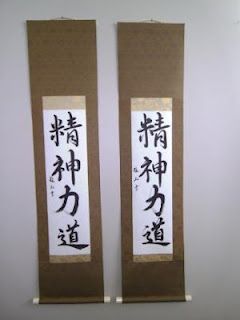
It is written in the Gyousho (Semi-cursive) style by Ryugyoku (Yoshimi Yamada Maples). I am very proud of the work she has done for me. Her writing is always consistent and brush strokes are always technically sound, even when there are multiple orders of the same saying or calligraphy.
The scrolls are finished with an ivory plastic jikusaki and usu kincha (gold) hanging string.
Dimensions as follows:
| Name in Kanji | Name in English | Size in Bun | Size in Inches |
| 天 | Ten | 100 | 11.93 |
| 上一文字 | Ue Ichimonji | 18 | 2.15 |
| 紙本の幅さ | Artwork Width | 57 | 6.80 |
| 紙本の長さ | Artwork Length | 202 | 24.10 |
| 柱 | Pillars | 17 | 2.03 |
| 下一文字 | Shita Ichimonji | 11 | 1.31 |
| 地 | Chi | 67 | 7.99 |
| 掛け軸の幅さ | Scroll Width | 91 | 10.86 |
| 掛け軸の長さ | Scroll Length | 398 | 47.48 |
